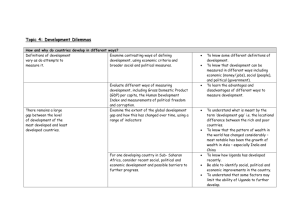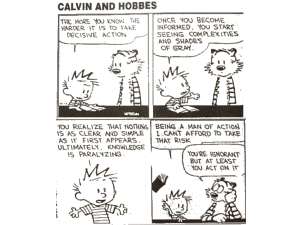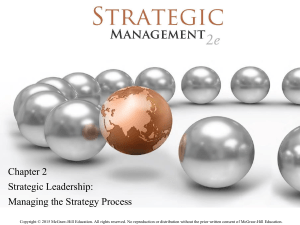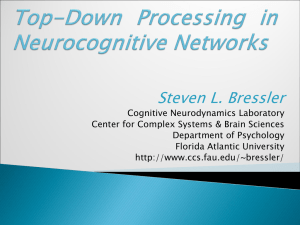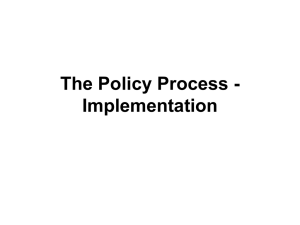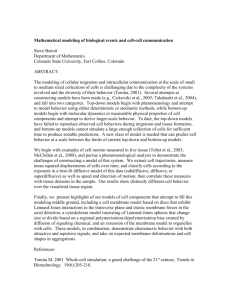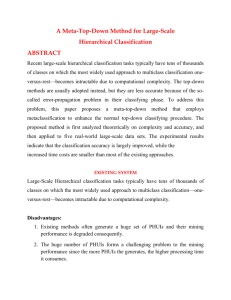Top-down organizational change initiatives
advertisement
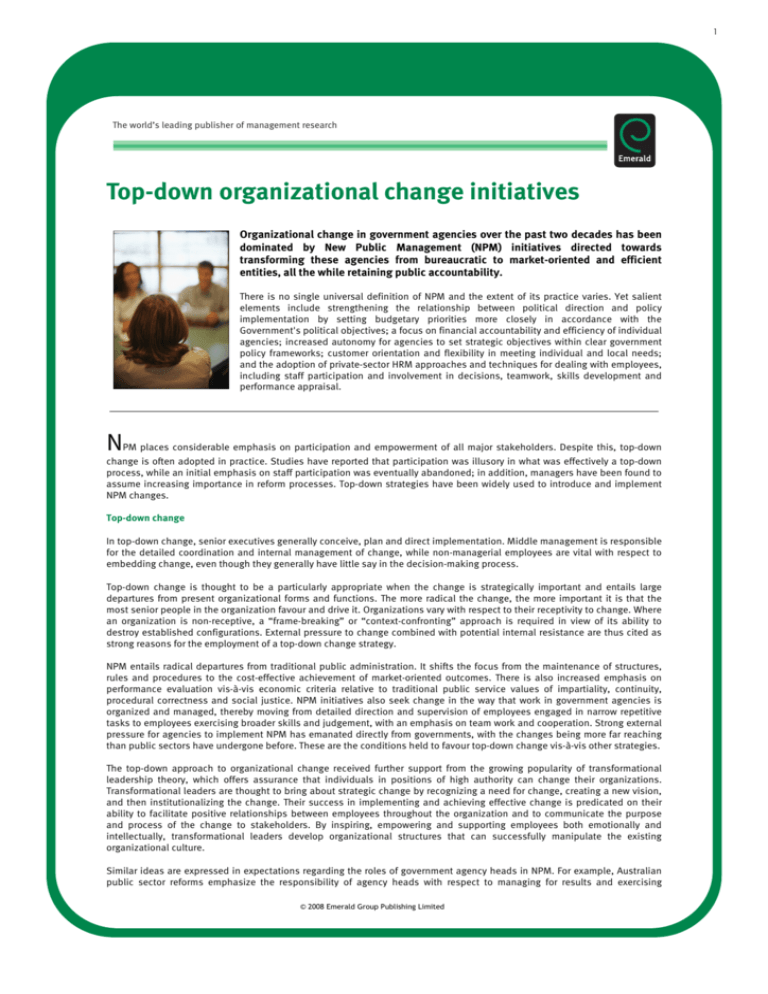
1 The world’s leading publisher of management research Top-down organizational change initiatives Organizational change in government agencies over the past two decades has been dominated by New Public Management (NPM) initiatives directed towards transforming these agencies from bureaucratic to market-oriented and efficient entities, all the while retaining public accountability. There is no single universal definition of NPM and the extent of its practice varies. Yet salient elements include strengthening the relationship between political direction and policy implementation by setting budgetary priorities more closely in accordance with the Government's political objectives; a focus on financial accountability and efficiency of individual agencies; increased autonomy for agencies to set strategic objectives within clear government policy frameworks; customer orientation and flexibility in meeting individual and local needs; and the adoption of private-sector HRM approaches and techniques for dealing with employees, including staff participation and involvement in decisions, teamwork, skills development and performance appraisal. N PM places considerable emphasis on participation and empowerment of all major stakeholders. Despite this, top-down change is often adopted in practice. Studies have reported that participation was illusory in what was effectively a top-down process, while an initial emphasis on staff participation was eventually abandoned; in addition, managers have been found to assume increasing importance in reform processes. Top-down strategies have been widely used to introduce and implement NPM changes. Top-down change In top-down change, senior executives generally conceive, plan and direct implementation. Middle management is responsible for the detailed coordination and internal management of change, while non-managerial employees are vital with respect to embedding change, even though they generally have little say in the decision-making process. Top-down change is thought to be a particularly appropriate when the change is strategically important and entails large departures from present organizational forms and functions. The more radical the change, the more important it is that the most senior people in the organization favour and drive it. Organizations vary with respect to their receptivity to change. Where an organization is non-receptive, a “frame-breaking” or “context-confronting” approach is required in view of its ability to destroy established configurations. External pressure to change combined with potential internal resistance are thus cited as strong reasons for the employment of a top-down change strategy. NPM entails radical departures from traditional public administration. It shifts the focus from the maintenance of structures, rules and procedures to the cost-effective achievement of market-oriented outcomes. There is also increased emphasis on performance evaluation vis-à-vis economic criteria relative to traditional public service values of impartiality, continuity, procedural correctness and social justice. NPM initiatives also seek change in the way that work in government agencies is organized and managed, thereby moving from detailed direction and supervision of employees engaged in narrow repetitive tasks to employees exercising broader skills and judgement, with an emphasis on team work and cooperation. Strong external pressure for agencies to implement NPM has emanated directly from governments, with the changes being more far reaching than public sectors have undergone before. These are the conditions held to favour top-down change vis-à-vis other strategies. The top-down approach to organizational change received further support from the growing popularity of transformational leadership theory, which offers assurance that individuals in positions of high authority can change their organizations. Transformational leaders are thought to bring about strategic change by recognizing a need for change, creating a new vision, and then institutionalizing the change. Their success in implementing and achieving effective change is predicated on their ability to facilitate positive relationships between employees throughout the organization and to communicate the purpose and process of the change to stakeholders. By inspiring, empowering and supporting employees both emotionally and intellectually, transformational leaders develop organizational structures that can successfully manipulate the existing organizational culture. Similar ideas are expressed in expectations regarding the roles of government agency heads in NPM. For example, Australian public sector reforms emphasize the responsibility of agency heads with respect to managing for results and exercising © 2008 Emerald Group Publishing Limited 2 effective leadership by articulating clear messages about overall government direction, improving two-way communication with staff, and rewarding good performance. Leadership training for members of senior executive services focuses on the articulation of organizational goals to staff with a view to creating a sense of common purpose, developing and marketing corporate visions both internally and externally, and developing the leadership competencies and organizational perspectives necessary for implementing organizational change. “Top-down change strategies have been criticized for assuming that organizational transformation is a linear and uniform process, for ignoring the processual and ongoing nature of large-scale change, and for failing to acknowledge the uniqueness of individual organizations.” Top-down change strategies have been criticized for assuming that organizational transformation is a linear and uniform process, for ignoring the processual and ongoing nature of large-scale change, and for failing to acknowledge the uniqueness of individual organizations. Critics argue that those at lower levels may not share senior management's commitment to the change and that, when problems and obstacles are encountered during implementation, senior management’s enthusiasm alone is not enough to sustain the change momentum. Organizational members seek to preserve the status quo and successful change is unlikely without overall commitment. A problem with both the top-down and bottom-up approaches is that neither adequately provides for middle managers. The centre-down approach assigns a more active role to these employees as initiators of change in their respective areas of responsibility. Middle managers interpret what the change envisaged by top management means in the context of their areas before identifying and planning the changes that they think are necessary. The centre-out approach promotes collaboration between middles managers by means of networks that coordinate and support diverse new initiatives. This approach includes horizontal project groups that cut across structural divisions and allow different organizational parts to collaborate, structures based on core processes that give priority to achieving horizontal coordination between the organizational units that are interdependent within each core process, and matrix structures that attempt to accommodate the growing need for horizontal coordination while, at the same time, maintain vertical control. Vertical slices provide a means of integrating change by enabling different organizational levels to communicate directly with each other. These alternative approaches to organizational change are not mutually exclusive. Indeed, some organizations have combined them. It is important to identify the specific distinctive contribution that each alternative makes to change and the way in which these contributions relate to each other. In such a combined strategy: • • • The alternatives Several alternatives to top-down change exist. The bottomup approach creates conditions for direct employee participation that top-down change generally does not provide. The term is used to describe widely different organizational arrangements that vary, especially with respect to the amount of decision-making authority delegated to staff. Some suggest that collocated workers have little authority to make decisions about work patterns, while quality circles can only make recommendations for changes in workplaces still controlled by supervisors, even though semi-autonomous groups do have some decisionmaking powers. “Manager-led teams” execute work that other people design, monitor and manage, “self-managing teams” have significant responsibility for managing their own work, although others make decisions about goals, team structure and organizational supports, while “self governing teams” choose their own goals in negotiation with management, and execute and manage their own work design. • • The top-down element is essential for developing and communicating senior management’s overall vision of change and for sustaining high-level support. The centre-down approach is essential for involving middle managers as active participants by planning initiatives in their areas of responsibility that need to be consistent with the senior management vision, yet address real issues. The centre-out approach encourages horizontal collaboration and integration and is particularly important for changes transcending structural boundaries. The bottom-up strategy enables employees to determine changes in how they work that would turn management’s vision into reality, whilst at the same time meeting local operating requirements and employee needs. Vertical slices strengthen interaction between senior management, middle management and employee levels whilst the change is being carried out. Despite criticism and the availability of alternatives, planned change in many organizations relies heavily on the top-down approach. A good combination Some have argued that the daunting challenge of © 2008 Emerald Group Publishing Limited 3 introducing radical organizational change under external pressures, such as NPM, requires strong leaders who impose change and use coercive methods in order to overcome resistance. As a result, top-down change has been widely used in efforts to bring about public sector reform. However, although the top-down approach can be effective with regard to initiating and sustaining high-level support for change, it does not sufficiently permeate all levels of an organization and achieve sustained changes in day-to-day operations. This is especially so when top-down change is mated with short-term transformational leadership. Furthermore, the concept of genuine two-way communication flow, or rather the employee expectation of this, becomes especially clear from a review of the findings, in addition to the increasing expectation of employee involvement in strategic decision-making. An espousal of such a communication and consultation strategy, and then the perception that it has not been achieved or fully utilized, can have a detrimental effect on the credibility of other aspects of the change. Thus a broader and deeper approach combining change driven from above, from the middle, and from below, offers better prospects. May 2008. This is a shortened version of “Top-down organizational change in an Australian Government agency”, which originally appeared in the International Journal of Public Sector Management, Volume 21 Number 1, 2008. The authors are Neal Ryan, Trevor Williams, Michael Charles and Jennifer Waterhouse. © 2008 Emerald Group Publishing Limited

